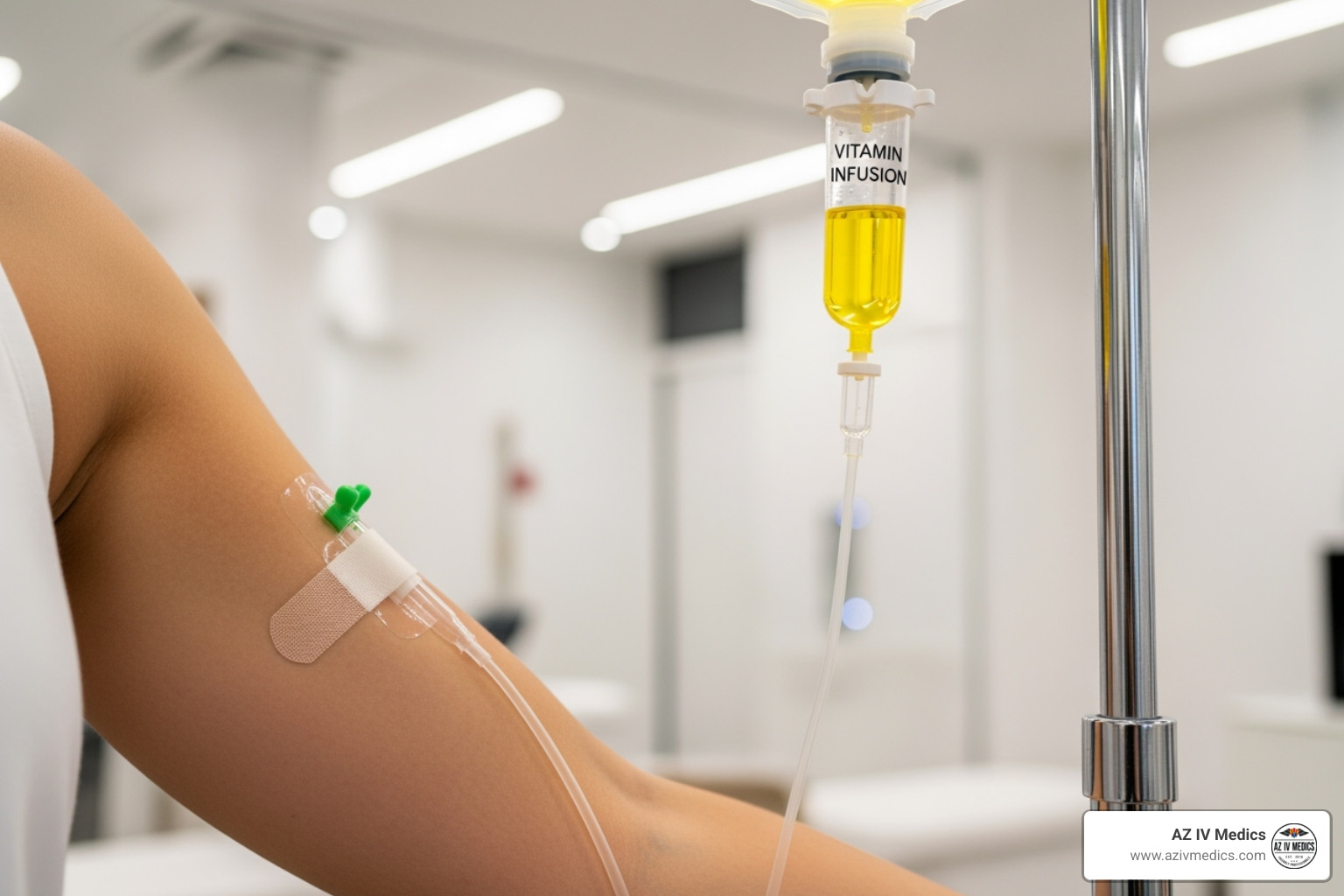IV Bolus Administration: Safe, Rapid Medication and Fluid Delivery
Joseph Lopez • May 23, 2023

Have you ever wanted to learn more about IV Bolus administration? This article is for you! In this article, we will cover everything you need to know about IV Bolus administration, including what it is, how it's different from other IV methods, what medications and fluids can be administered via IV bolus, the indications for IV bolus administration, how to prepare for it, and the potential complications and risks. So let's delve deeper into this subject to help you better understand IV bolus administration.
Understanding IV Bolus Administration
IV Bolus administration is a method of quickly administering medication or fluids through an intravenous (IV) catheter. Compared to other IV methods, such as drip or infusion, bolus administration delivers medication rapidly, usually within seconds or minutes. This makes it particularly useful in emergency situations and when there is a need for immediate medication or fluid replacement.
However, there are certain risks associated with IV bolus administration, such as the potential for medication errors or adverse reactions. Therefore, it is essential to have trained healthcare professionals who can accurately administer and monitor IV bolus medications and fluids.
Definition and Purpose of IV Bolus
IV bolus is the administration of a concentrated dose of medication or fluid directly into a vein. The purpose of IV bolus is to quickly deliver a prescribed dose of medication or fluid to the patient's bloodstream for immediate effect. This may be required in certain medical emergencies or situations where quick treatment is necessary.
For example, in the case of a severe allergic reaction, such as anaphylaxis, IV bolus administration of epinephrine can quickly reverse the symptoms and prevent life-threatening complications.
How IV Bolus Differs from Other IV Methods
While other IV methods, such as infusions or drips, may deliver medication or fluids over a more extended period, IV bolus delivers the same amount in a much shorter period. This rapid delivery is particularly helpful in medical emergency situations where patients require immediate medication or fluid replacement to maintain their lives.
However, it is important to note that IV bolus administration may not be suitable for all patients. For example, patients with certain medical conditions, such as heart disease or kidney failure, may require slower IV methods to prevent complications.
Common Medications and Fluids Administered via IV Bolus
The primary pharmaceuticals and fluids delivered via IV bolus include painkillers, antibiotics, electrolyte replacement fluids, and IV push drugs. Additionally, IV bolus may be used to administer chemotherapy, antiarrhythmics, and sedatives. A doctor or healthcare professional will prescribe medication or fluid for administration via IV bolus and calculate the optimal rate and dosage depending on the patient's condition and medical history.
It is also important to note that IV bolus administration requires careful monitoring to ensure that the patient receives the correct dose and does not experience any adverse reactions. Healthcare professionals should be trained to recognize and respond to any potential complications that may arise during IV bolus administration.
Indications for IV Bolus Administration
IV Bolus administration is a medical procedure that involves the quick injection of medication or fluids into a patient's veins. It may be indicated in various medical emergencies to facilitate fast treatment delivery. The following are some of the top indications for IV bolus administration:
Emergency Situations
The administration of medication or fluids may be critical in emergency situations, such as cardiac arrest or severe anaphylactic reactions, where patients require immediate treatment for survival and optimal results. In these situations, time is of the essence, and IV bolus administration allows for rapid delivery of life-saving medications and fluids. The procedure can help stabilize the patient's condition and improve their chances of recovery.
Medication Administration
IV bolus administration may be used when medications need to be delivered quickly and efficiently, such as pain relief or antibiotic treatment. The procedure allows for the medication to be delivered directly into the bloodstream, bypassing the digestive system, which can delay the onset of action. This method is particularly useful when a patient is unable to take medication orally, such as when they are unconscious or experiencing vomiting or diarrhea.
Additionally, IV bolus administration can be used to administer medications that are not available in oral form or that require careful monitoring, such as chemotherapy drugs or anticoagulants.
Fluid and Electrolyte Replacement
Administering fluids and electrolytes via IV bolus is critical in emergencies such as severe dehydration, high fevers, or electrolyte imbalances that may be difficult to correct through oral replacement methods. The procedure allows for rapid delivery of fluids and electrolytes directly into the bloodstream, which can help restore the patient's fluid and electrolyte balance quickly.
IV bolus administration can also be used to administer nutrition, such as total parenteral nutrition, to patients who are unable to eat or digest food normally due to illness or surgery.
In conclusion, IV bolus administration is a valuable medical procedure that can be used in various emergency and non-emergency situations to facilitate fast and efficient treatment delivery. It allows for the rapid delivery of medications, fluids, electrolytes, and nutrition directly into the bloodstream, which can help improve patient outcomes and save lives.
Preparing for IV Bolus Administration
Before administering IV bolus, healthcare professionals should complete the following steps:
Gathering Necessary Supplies
To administer IV bolus, healthcare professionals need an IV catheter, syringe, and the prescribed medication or fluid and related supplies. The IV catheter should be of appropriate size depending on the patient's age and size. The syringe should also be of appropriate size to ensure accurate measurement of the medication or fluid. It is important to check the expiration date of all supplies before use.
Patient Assessment and Consent
Healthcare professionals should evaluate the patient's medical history, allergies, and medication interactions, and confirm the patient's consent for bolus administration. The healthcare professional should also assess the patient's current condition, including vital signs and overall well-being, to ensure that the administration of the medication or fluid is appropriate.
It is important to communicate with the patient and explain the procedure, including any potential side effects or risks associated with the medication or fluid administration. The healthcare professional should also ensure that the patient understands the procedure and is comfortable with it before proceeding.
Calculating Dosage and Rate
The healthcare professional should ensure they have calculated the correct dosage and rate of medication or fluid administration based on the patient's weight, medical history, and overall condition. It is important to double-check the dosage and rate calculations to ensure accuracy.
The healthcare professional should also consider any potential adverse reactions to the medication or fluid and have appropriate measures in place to manage them. They should also monitor the patient closely during and after the administration of the medication or fluid.
In addition, the healthcare professional should document the administration of the medication or fluid, including the dosage, rate, and any adverse reactions or complications that may arise.
By following these steps, healthcare professionals can ensure safe and effective administration of IV bolus and minimize the risk of adverse reactions or complications.
Step-by-Step Guide to IV Bolus Administration
The following are the essential steps involved in IV bolus administration:
Preparing the Medication or Fluid
One of the initial steps in administering IV bolus is preparing the medication or fluid that needs to be administered. This includes removing the medication or fluid from its packaging and ensuring it is ready for the next step.
It is crucial to verify the medication or fluid is the correct one and that it is at the appropriate temperature and concentration. The healthcare professional should also check for any particulate matter or discoloration that may indicate contamination.
Additionally, the healthcare professional should review the medication or fluid's indications, contraindications, and potential adverse reactions to ensure patient safety and proper administration.
Inserting the IV Catheter
The next step is to insert the IV catheter into the patient's vein while maintaining proper sterile technique. The healthcare professional should verify the correct placement of the catheter and maintain positioning during the bolus administration.
Before inserting the catheter, the healthcare professional should assess the patient's veins for any abnormalities or potential complications. They should also explain the procedure to the patient and obtain informed consent.
During the insertion, the healthcare professional should use aseptic technique to prevent infection and minimize the risk of complications. They should also secure the catheter in place and label it with the date and time of insertion.
Administering the Bolus
Once the catheter is appropriately placed, the healthcare professional can administer the medication or fluid via the IV bolus route using a syringe. It is essential to monitor the rate of administration and the patient's vital signs during the process.
The healthcare professional should use a syringe with a volume appropriate for the medication or fluid being administered. They should also use a sterile needle and avoid touching the plunger or needle to prevent contamination.
The healthcare professional should slowly inject the medication or fluid over the recommended time frame while monitoring the patient's vital signs for any adverse reactions. If the patient experiences any discomfort or adverse reactions, the healthcare professional should stop the bolus immediately and assess the patient.
Monitoring the Patient During and After Administration
After the bolus administration, the healthcare professional should monitor the patient for any adverse reactions or side effects. Monitoring checks should include the patient's blood pressure, pulse rate, respiratory rate, and other relevant vital signs.
The healthcare professional should also assess the patient for any signs of infiltration, phlebitis, or infection at the catheter site. They should document the administration and any adverse reactions or complications in the patient's medical record.
Furthermore, the healthcare professional should educate the patient about the medication or fluid being administered and any potential side effects or adverse reactions. They should also provide instructions for any follow-up care or monitoring.
Overall, IV bolus administration is a critical procedure that requires proper preparation, technique, and monitoring to ensure patient safety and optimal outcomes.
Potential Complications and Risks
The following are known complications and risks associated with IV bolus administration:
Infiltration and Extravasation
Infiltration occurs when the infused medication or fluid leaks into the surrounding tissue instead of flowing through the bloodstream. Extravasation involves medication or fluid seeping out of the vein into surrounding tissues. Infiltration and extravasation can cause pain, swelling, redness, and tissue damage. In severe cases, tissue necrosis may occur, leading to the need for surgical intervention.
Infection
Infection may occur as a result of catheter insertion if proper sterile technique is not observed. Healthcare professionals should follow established protocols to mitigate the risk of infection. Infection can cause localized redness, swelling, pain, and fever. In severe cases, sepsis may occur, which can be life-threatening.
Air Embolism
When air enters the bloodstream, air embolism can occur, which can be life-threatening. This may happen if the catheter inserted is not completely sealed, as air may enter the blood vessels. Air embolism can cause chest pain, shortness of breath, confusion, and loss of consciousness. Immediate medical attention is required to prevent further complications.
Adverse Reactions to Medications or Fluids
The medication or fluid delivered via IV bolus may cause adverse reactions such as allergic reactions, side effects, or anaphylaxis, depending on the administered drug or fluid's nature. Healthcare professionals should monitor patients closely for any signs of adverse reactions and take appropriate action if necessary. In severe cases, the patient may require emergency medical treatment.
In addition to the above risks, IV bolus administration may also cause discomfort, bruising, or hematoma at the injection site. Patients should inform their healthcare provider if they experience any of these symptoms.
It is essential to discuss the potential risks and benefits of IV bolus administration with your healthcare provider before undergoing the procedure. Healthcare professionals should follow established protocols and guidelines to minimize the risk of complications and ensure patient safety.
Tips for Safe and Effective IV Bolus Administration
IV bolus administration is a common procedure used to deliver medications or fluids directly into a patient's bloodstream. While the process is generally safe and effective, healthcare professionals must follow specific guidelines to ensure patient safety and prevent complications. Here are some additional tips to ensure safe and effective IV bolus administration:
Proper Technique and Sterile Procedure
Before inserting the catheter, healthcare professionals should ensure they have all the necessary supplies, including gloves, a catheter, and an antiseptic solution. They should also follow the correct process for inserting the catheter and administering medications or fluids. This process includes cleaning the injection site, inserting the catheter at the correct angle, and securing the catheter in place. Healthcare professionals should exercise the right techniques around catheter maintenance and removal to avoid any complications.
It is essential to maintain a sterile environment during the procedure to prevent infections. Healthcare professionals should wear gloves and use an antiseptic solution to clean the injection site before inserting the catheter. They should also use a sterile dressing to cover the injection site after the procedure.
Patient Education and Communication
Before commencing IV bolus administration, healthcare professionals should explain the process to the patient to ensure the patient is aware of what to expect. This includes the injection site, the possible complications, and any adverse reactions that may occur after the procedure. Healthcare professionals should also inform the patient of the benefits of the procedure and how it will help improve their condition.
It is crucial to communicate effectively with the patient throughout the procedure to ensure their comfort and safety. Healthcare professionals should explain each step of the process as they go and ask the patient how they are feeling. They should also inform the patient of any changes in their condition and what they can expect during the recovery period.
Regularly Assessing and Documenting Patient Response
After the procedure, healthcare professionals should monitor the patient regularly, assess their response, document their condition, and report any changes. This will allow healthcare professionals to adjust their approach as necessary and collaborate with colleagues to provide the best possible care for their patients.
Regular monitoring can help identify any complications early on and prevent them from becoming more severe. Healthcare professionals should document the patient's vital signs, including blood pressure, heart rate, and oxygen saturation levels. They should also monitor the patient's fluid intake and output and assess their response to the medications administered.
In conclusion, IV bolus administration is a safe and effective procedure when performed correctly. Healthcare professionals must follow proper technique and sterile procedure, communicate effectively with the patient, and regularly assess and document their response to ensure the best possible outcome.
Conclusion
IV bolus administration is an essential medical procedure used to deliver rapid medication or fluid replacement to patients. Healthcare professionals must understand the indications for IV bolus administration, how to prepare for it, the potential complications and risks, and tips to ensure effective and safe IV bolus administration. By following established protocols, healthcare professionals can safely and effectively administer medications and fluids via IV bolus and improve patient outcomes.




